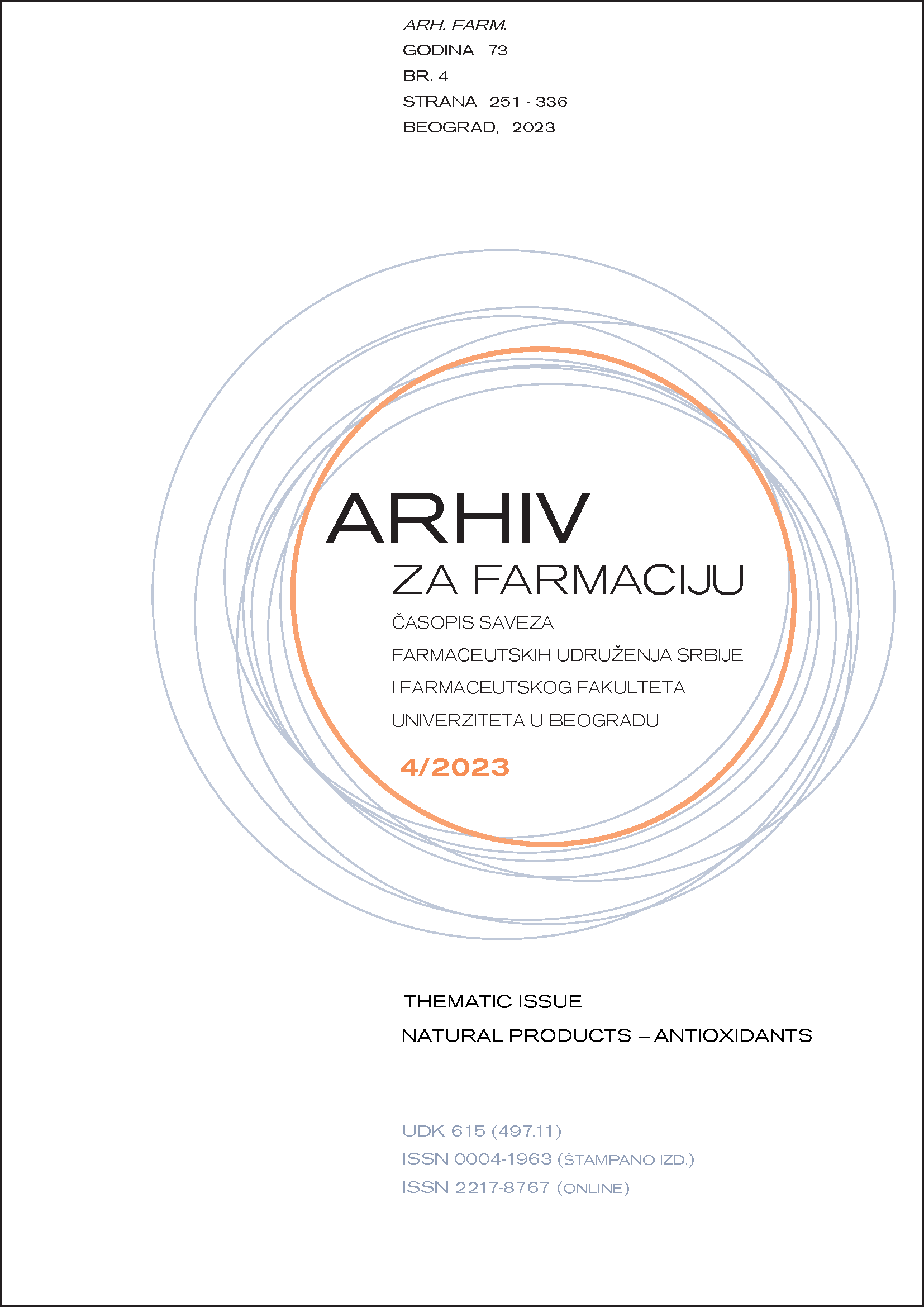Methods for the determination of antioxidant activity of plant extracts in vitro
Abstract
Plants are rich sources of secondary metabolites that exhibit diverse biological and pharmacological effects. Some plant ingredients, primarily phenolics, have significant in vitro antioxidant activity, thus implicating their contribution to the maintenance of redox balance in the body. These potential antioxidant agents are structurally very diverse, having different mechanisms of antioxidant activity. Since there is a growing necessity to detect, develop and understand effective antioxidant compounds, interest in the identification and the measurement of antioxidants in various plant isolates is persistently growing and many methods are being established. Most of the available in vitro tests are affordable and easy to perform, but due to the complex composition of plant extracts, different kinetics, mechanisms and specificity of the chemical reactions underlying these tests, there is no universal parameter for assessment of antioxidant activity. In this work, some of the currently most used in vitro methods for investigating and evaluating antioxidant activity of plant extracts are presented, emphasizing their advantages and weaknesses.
References
1. Niki E. Antioxidant capacity of foods for scavenging reactive oxidants and inhibition of plasma lipid oxidation induced by multiple oxidants. Food Funct. 2016;7(5):2156-68.
2. Hunyadi A. The mechanism(s) of action of antioxidants: From scavenging reactive oxygen/nitrogen species to redox signaling and the generation of bioactive secondary metabolites. Med Res Rev. 2019;39(6):2505-33.
3. Apak R. Current issues in antioxidant measurement. J Agric Food Chem. 2019;67(33):9187-202.
4. Nwachukwu ID, Sarteshnizi RA, Udenigwe CC, Aluko RE. A concise review of current in vitro chemical and cell-based antioxidant assay methods. Molecules. 2021;26(16):4865.
5. Shahidi F, Zhong Y. Measurement of antioxidant activity. J Funct Foods. 2015;18:757-81.
6. Schaich KM, Tian X, Xie J. Reprint of “Hurdles and pitfalls in measuring antioxidant efficacy: A critical evaluation of ABTS, DPPH, and ORAC assays.” J Funct Foods. 2015;18:782-96.
7. Halliwell B, Gutteridge JMC. Free Radicals in Biology and Medicine. 5th ed. Oxford: Oxford University Press; 2015. p. 77
8. Apak R, Gorinstein S, Böhm V, Schaich KM, Özyürek M, Güçlü K. IUPAC Technical Report: Methods of measurement and evaluation of natural antioxidant capacity/activity. Pure Appl Chem. 2013;85(5):957-998.
9. Amorati R, Foti MC, Valgimigli L. Antioxidant activity of essential oils. J Agric Food Chem. 2013;61(46):10835-47.
10. Sun Y, Yang C, Tsao R. Nomenclature and general classification of antioxidant activity/capacity assays. In: Apak R, Capanoglu E, Shahidi F, editors. Measurement of antioxidant activity & capacity. John Wiley & Sons, Ltd; 2018; p.1-19.
11. Magalhães LM, Segundo MA, Reis S, Lima JLFC. Methodological aspects about in vitro evaluation of antioxidant properties. Anal Chim Acta. 2008;613(1):1-19.
12. Amorati R, Valgimigli L. Advantages and limitations of common testing methods for antioxidants. Free Radic Res. 2015;49(5):633-649.
13. Haytowitz DB, Bhagwat S. USDA database for the oxygen radical absorbance capacity (ORAC) of selected foods, release 2; Nutrient Data Laboratory, Beltsville Human Nutrition Research Center (BHNRC), Agriculture Research Service (ARS), United States Department of Agriculture (USDA): Beltsville, MD; https://www.ars.usda.gov/research/publications/publication/?seqNo115=251105 (accessed Jun 16, 2023).
14. Halliwell B. Antioxidant characterization. Methodology and mechanism. Biochem Pharmacol. 1995;49.1341-8.
15. Niki E. Assessment of antioxidant capacity in vitro and in vivo. Free Rad Biol Med. 2010;49:503-15.
16. López‐Alarcón C, Denicola A. Evaluating the antioxidant capacity of natural products: a review on chemical and cellular‐based assays. Anal Chim Acta. 2013;763.1-10.
17. Apak R, Özyürek M, Güçlü K, Çapanoğlu E. Antioxidant activity/capacity measurement. 1. Classification, physicochemical principles, mechanisms, and electron transfer (ET)-based assays. J Agric Food Chem. 2016;64(5):997-1027.
18. Huang D, Ou B, Prior RL. The chemistry behind antioxidant capacity assays. J Agric Food Chem. 2005;53(6):1841-56.
19. Lamuela-Raventós RM. Folin–Ciocalteu method for the measurement of total phenolic content and antioxidant capacity. In: Apak R, Capanoglu E, Shahidi F, editors. Measurement of antioxidant activity & capacity. John Wiley & Sons, Ltd; 2018; p.107-15.
20. COMMISSION REGULATION (EEC) No 2676/90 determining Community methods for the analysis of wines. O J. 1990;74:170-1.
21. Ph. Eur. monograph 01/2008: 20814: Tannins in herbal drugs. European Pharmacopoeia 10.2. Strasbourg: Council of Europe; 2020.
22. Berker KI, Olgun FAO, Ozyurt D, Demirata B, Apak R. Modified Folin-Ciocalteu antioxidant capacity assay for measuring lipophilic antioxidants. J Agric Food Chem. 2013;61: 4783-91.
23. Apak R, Güçlü K, Özyürek M, Karademir SE. Novel total antioxidant capacity index for dietary polyphenols and vitamins C and E, using their cupric ion reducing capability in the presence of neocuproine: CUPRAC method. J Agric Food Chem. 2004;52:7970-81.
24. Apak R, Özyürek M, Güçlü K, Bekdeşer B, Bener M. The CUPRAC Methods of Antioxidant Measurement for Beverages. In: Preedy V, editor. Processing and Impact on Antioxidants in Beverages. San Diego: Academic Press; 2014; p. 235-44.
25. Locatelli M, Gindro R, Travaglia F, Coïsson JD, Rinaldi M, Arlorio M. Study of the DPPH-scavenging activity: Development of a free software for the correct interpretation of data. Food Chem. 2009;114(3):889-97.
26. Sharma OP, Bhat TK. DPPH antioxidant assay revisited. Food Chem. 2009;113(4):1202–5.
27. Cuendet M, Hostettmann K, Potterat O. Iridoid glucosides with free radical scavenging properties from Fagraea blumei. Helv Chim Acta. 1997;80:1144-52.
28. Niederländer HAG, van Beek TA, Bartasiute A, Koleva II. Antioxidant activity assays on-line with liquid chromatography. J Chrom. A. 2008 Nov 14;1210(2):121–34.
29. Xiao Y, Fu F, Wei Y, Shi S, Shan Y. Online Extraction–DPPH–HPLC–DAD–QTOF-MS System for Efficient Screening and Identification of Antioxidants from Citrus aurantium L. var. amara (Rutaceae): Integrating Sample Preparation and Antioxidants Profiling. Antioxidants. 2022;11:1014.
30. Wang X, Zuo G-L, Wang C-Y, Kim HY, Lim SS, Tong S-Q. An Off-Line DPPH-GC-MS Coupling Countercurrent Chromatography Method for Screening, Identification, and Separation of Antioxidant Compounds in Essential Oil. Antioxidants. 2020;9:702.

